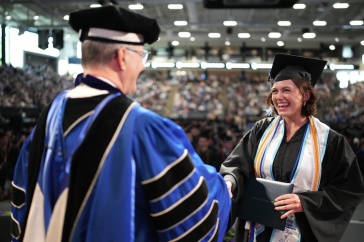
As an art student at UNH, Richard Whitney ’68 would pay his Phi Kappa Alta brothers five dollars to sit for their portrait, and then he’d give them the finished painting when he was done. Today, Whitney is a world-renowned artist who has painted hundreds of landscapes and portraits, including those of seven New Hampshire governors, four New Hampshire Supreme Court chief justices and 2012 Republican presidential nominee Mitt Romney. His latest piece, a portrait of retired chief justice John Broderick, was unveiled at the New Hampshire State House in September.
To some extent, Whitney’s success was predestined. Adopted by artistic parents who had spent two years searching for a child with an “exceptional” background, he showed his genius as early as age three, when his mother sat him down with crayons and paper. She wanted him to draw a house. The young boy, who would years later find out that his lineage included many artists including the famous French painter François Boucher, wasn’t interested, so she put the paper away. A week later he showed her a drawing: a knight on a horseback with a castle and a sunset. His parents knew then that they had a talented child—and they expected him to dedicate himself to whatever he wanted to do and to be good at it.
“They really put the pressure on me because that was a way I could show my affection,” Whitney says.
From elementary school on, Whitney won all sorts of awards for his work. At UNH, studying art in an era when abstract art and expressionism were in vogue, he convinced professor John Hatch to allow him to focus on classical painting, supplementing his coursework first with a summer portrait class taught by renowned realist Sidney F. Willis and later with private study under R.H. Ives Gammell, whose Twilight of Painting Whitney says “changed my life.” Widely hailed as one of the last classically trained realist painters, Gammell selected only two or three students at a time, whom he would then mentor for a period of five to six years.
After college, Whitney moved to Keene, N.H., and eked out a living painting portraits. After struggling to pay the bills for a couple of years, he reconnected with Willis, who suggested he go to Boston and show his paintings to galleries on Newbury Street. Whitney followed Willis’ advice, and got his first real break when Vose Galleries in Boston offered him his first big commission.
“They said, we hate to insult you, but can you paint a portrait for a thousand dollars?” Whitney recalls. “I said sure I could—I’d been doing them for a hundred bucks!”
Today, the 68-year-old Whitney lives with his artist wife, Sandy Sherman, on 81 acres of land in Stoddard, N.H. It’s an artist’s paradise, surrounded by some 12,000 acres of conserved land. He figures he has completed around 400 portraits and 300 landscapes at this point in his career, some of which have taken longer than others. His Romney portrait, for example, took him about 150 hours.
When he’s not painting, Whitney is revising his 1995 book, Painting the Visual Impression, which he plans to rerelease on Amazon and as an ebook. The book includes notes he took while studying with Gammell. He’s also busy giving lectures and running workshops.
“I was meant to do what I’m doing,” Whitney says. “Fortunately, in the last 10 to 20 years, realism has been exploding worldwide, so now I’m internationally known in my field, which is very nice.”
Just as nice is the lasting bond between Whitney and UNH. Fifty years after he paid people in order to paint their likeness, Whitney says that some of his Phi Kappa Alpha brothers still have their portraits—and two of them bought some of his paintings not too long ago.
Originally published in UNH Magazine—Fall 2014 Issue
-
Written By:
Michele Filgate '06 | Freelance Writer
















































